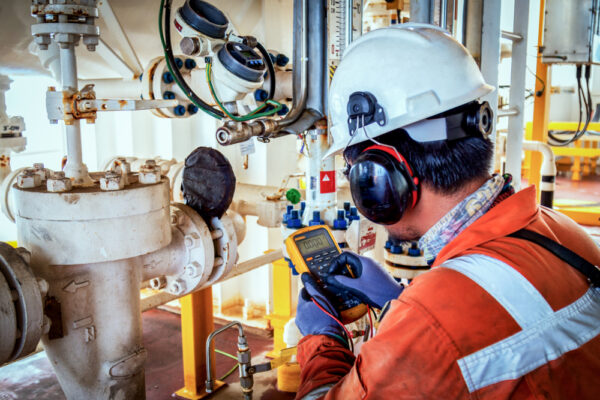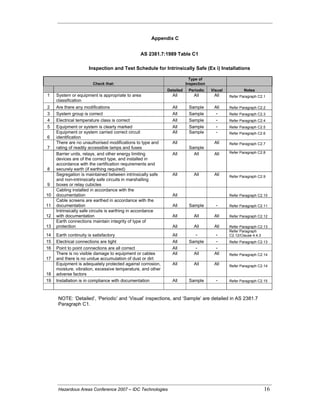The Basic Principles Of Roar Solutions
The Basic Principles Of Roar Solutions
Blog Article
Some Known Factual Statements About Roar Solutions
Table of ContentsAbout Roar SolutionsThe Facts About Roar Solutions RevealedRoar Solutions - The Facts
In order to secure installations from a potential surge a technique of analysing and identifying a possibly unsafe location is called for. The objective of this is to guarantee the right choice and setup of devices to inevitably avoid an explosion and to make certain safety and security of life.
(https://www.brownbook.net/business/53579326/roar-solutions/)
No devices ought to be set up where the surface area temperature of the tools is higher than the ignition temperature of the provided danger. Below are some usual dust harmful and their minimal ignition temperature level. Coal Dirt 380C 225C Polythene 420C (melts) Methyl Cellulose 420C 320C Starch 460C 435C Flour 490C 340C Sugar 490C 460C Grain Dust 510C 300C Phenolic Material 530C > 450C Aluminium 590C > 450C PVC 700C > 450C Residue 810C 570C The chance of the threat being present in a focus high sufficient to trigger an ignition will differ from place to area.
Unsafe location electric equipment perhaps created for usage in higher ambient temperatures. Field Repair By Authorised Personnel: Complicated screening might not be needed nevertheless certain procedures may need to be adhered to in order for the equipment to preserve its 3rd event ranking. Each piece of devices with a harmful score need to be examined individually.
Not known Incorrect Statements About Roar Solutions
The devices register is an extensive data source of tools records that consists of a minimum collection of fields to identify each product's place, technological specifications, Ex lover classification, age, and environmental data. This details is crucial for monitoring and handling the tools efficiently within dangerous locations. In contrast, for regular or RBI sampling inspections, the grade will certainly be a combination of Comprehensive and Close examinations. The proportion of Detailed to Close examinations will be determined by the Tools Risk, which is examined based upon ignition risk (the likelihood of a resource of ignition versus the probability of a flammable ambience )and the hazardous area category
( Area 0, 1, or 2). This variant will likewise affect the resourcing needs for work preparation. When Whole lots are specified, you can develop sampling strategies based on the sample size of each Great deal, which describes the variety of arbitrary tools items to be examined. To figure out the needed example dimension, 2 facets require to be evaluated: the size of the Lot and the category of evaluation, which suggests the degree of initiative that must be used( lowered, typical, or boosted )to the evaluation of the Great deal. By integrating the classification of examination with the Whole lot dimension, you can after that establish the suitable being rejected requirements for a sample, implying the allowable number of damaged things located within that example. For more details on this procedure, please describe the Energy Institute Guidelines. The IEC 60079 conventional suggests that the maximum period in between inspections should not exceed 3 years. EEHA examinations will certainly likewise be conducted beyond RBI campaigns as part of set up upkeep and devices overhauls or repairs. These inspections can be attributed toward the RBI example sizes within the affected Whole lots. EEHA examinations are carried out to identify mistakes in electrical tools. A heavy scoring system is necessary, as a single item of tools may have multiple mistakes, each with varying degrees of ignition risk. If the consolidated score of both inspections is much less than two times the fault rating, the Great deal is deemed appropriate. If the Lot is still taken into consideration inappropriate, it has to go through a complete assessment or justification, which might trigger more stringent inspection procedures. Accepted Lot: The sources of any mistakes are recognized. If a typical failing mode is discovered, additional devices might require maintenance. Faults are identified by seriousness( Safety and security, Integrity, House cleaning ), ensuring that urgent concerns are assessed and attended to without delay to reduce any effect on safety or procedures. The EEHA data source should track and tape the lifecycle of mistakes together with the rehabilitative actions taken. Executing a robust Risk-Based Examination( RBI )strategy is important for making certain compliance and safety in handling Electrical Devices in Hazardous Locations( EEHA) (eeha training). Automated Mistake Rating and Lifecycle Monitoring: Easily take care of mistakes and track their lifecycle to boost inspection accuracy. The introduction of this assistance for risk-based examination additionally enhances Inspectivity's position as a best-in-class solution for governing compliance, along with for any kind of asset-centric assessment usage case. If you want finding out more, we welcome you to ask for a demonstration and find just how our remedy can change your EEHA management processes.
Roar Solutions Fundamentals Explained

In terms of explosive risk, a harmful location is an atmosphere in which an eruptive atmosphere is present (or may be anticipated to be present) in amounts that need special preventative measures for the building and construction, installation and use equipment. high voltage courses. In this write-up we check out the obstacles encountered in the office, the risk control procedures, and the required competencies to work securely
It issues of contemporary life that we manufacture, save or manage a series of gases or fluids that are considered flammable, and a variety of dirts that are regarded combustible. These compounds can, in certain problems, form explosive atmospheres and these can have major and awful effects. Many of us recognize with the fire triangle remove any one of the 3 components and the fire can not take place, however what does this mean in the context of unsafe areas? When damaging this down into its most basic terms it is basically: a mix of a particular quantity of release or leakage of a particular compound or product, blending with ambient oxygen, and the visibility of a source of ignition.
In many instances, we can do little regarding the he said degrees of oxygen airborne, however we can have considerable impact on resources of ignition, for instance electric devices. Hazardous areas are documented on the dangerous area classification drawing and are determined on-site by the triangular "EX LOVER" indication. Right here, amongst other essential info, areas are split right into three types depending upon the danger, the chance and period that an eruptive environment will certainly exist; Area 0 or 20 is considered the most dangerous and Area 2 or 22 is deemed the least.
Report this page